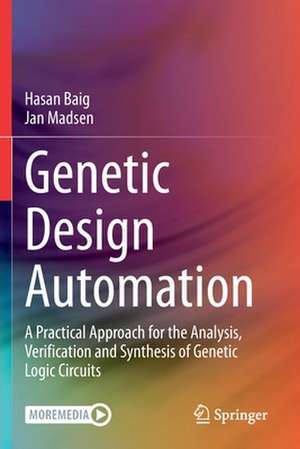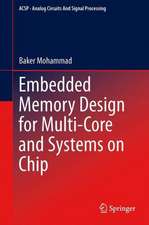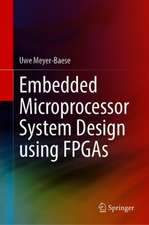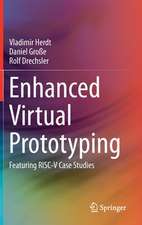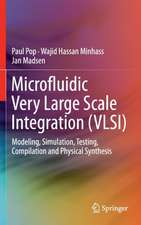Genetic Design Automation: A Practical Approach for the Analysis, Verification and Synthesis of Genetic Logic Circuits
Autor Hasan Baig, Jan Madsenen Limba Engleză Paperback – 27 sep 2021
| Toate formatele și edițiile | Preț | Express |
|---|---|---|
| Paperback (1) | 381.59 lei 6-8 săpt. | |
| Springer International Publishing – 27 sep 2021 | 381.59 lei 6-8 săpt. | |
| Hardback (1) | 388.72 lei 6-8 săpt. | |
| Springer International Publishing – 26 sep 2020 | 388.72 lei 6-8 săpt. |
Preț: 381.59 lei
Nou
Puncte Express: 572
Preț estimativ în valută:
73.03€ • 75.44$ • 60.78£
73.03€ • 75.44$ • 60.78£
Carte tipărită la comandă
Livrare economică 25 martie-08 aprilie
Preluare comenzi: 021 569.72.76
Specificații
ISBN-13: 9783030523572
ISBN-10: 3030523578
Pagini: 164
Ilustrații: XVI, 164 p. 158 illus., 148 illus. in color.
Dimensiuni: 155 x 235 x 12 mm
Greutate: 0.26 kg
Ediția:1st ed. 2020
Editura: Springer International Publishing
Colecția Springer
Locul publicării:Cham, Switzerland
ISBN-10: 3030523578
Pagini: 164
Ilustrații: XVI, 164 p. 158 illus., 148 illus. in color.
Dimensiuni: 155 x 235 x 12 mm
Greutate: 0.26 kg
Ediția:1st ed. 2020
Editura: Springer International Publishing
Colecția Springer
Locul publicării:Cham, Switzerland
Cuprins
Introduction.- Fundamentals of Molecular Biology and Genetic Circuits.- Dynamic Virtual Analyzer and Simulator.- Genetic Circuits Timing Analysis.- Genetic Circuits Logic Analysis.- Technology Mapping of Genetic Circuits.- Parameter Estimation and Sensitivity Analysis.- Learn to program rapidly with graphical programming.- Project 1 – Stochastic Simulation.- Project 2 – Parsing SBML.- Project 3 – Circuit generation with SBOL.
Notă biografică
Hasan Baig is currently serving as a Postdoctoral Research Fellow at University of Connecticut (UConn Health) USA, where he is working on the development of cloud-based computational biology tools. Earlier, he served as an Assistant Professor at Habib University, Pakistan where he was involved in teaching undergrad courses related to computer science and electrical engineering. More specifically, he designed and taught courses related to digital embedded systems and processor architecture. Hasan also developed customized software/hardware experimentation platforms to help students in performing interactive laboratory experiments related to these courses. The resources can be accessed freely at https://www.hasanbaig.com/resources. Besides this, he is also actively involved in supervising undergrad and postgraduate research projects related to genetic design automation and FPGAs. He is also serving as an editor to Synthetic Biology Open Language (SBOL) which is an open standard for the representation of in silico biological designs. He has published several peer-reviewed journal, conference, and workshop research papers, and also hold international patents. Besides teaching and research, he has also worked for design industries based in USA, South Korea, and Pakistan, where he worked on different projects including human-machine interface development for bio-electronic devices; development of USB 3.0 PHY layer controller; NAND-flash based solid state data storage devices; different software for car tracking, remote monitoring of fuel tanks etc. Inspired from electric and genetic technologies, he has founded a company named ElepTic (ELEctric Plus geneTIC) Technologies which focuses on the development of integrated electronic and genetic development platforms.
Hasan holds a PhD degree in Computer Science (genetic design automation) from the Technical University of Denmark. During his doctoral studies, he worked on a future emerging technology in the domain of Design Automation for Synthetic Biology. His contribution in this field is to develop methods, algorithms and tools for the analysis, verification and synthesis of genetic logic circuits. Earlier, he obtained his MS (Computer Engineering) and BE (Electronic Engineering) from Chosun University (South Korea) and NED University (Pakistan), respectively. His research interests include genetic design automation, embedded systems design, fault-tolerant systems, programmable genetic design platforms, and microfluidic platforms.
Jan Madsen is Full Professor in Computer-Based Systems and Deputy Director of the Department of Applied Mathematics and Computer Science (DTU Compute), Technical University of Denmark (DTU). He is heading the section on Embedded Systems Engineering at DTU Compute, which are doing research in embedded and cyber-physical systems related to the computing continuum from sensor to cloud. His research interests include design, modelling, analysis,optimization and construction of microelectronic, microfluidic and microbiological computing systems. He has published more than 200 peer-reviewed journal and conference papers, 13 book chapters, 3 books and 4 edited books. He is national ICT expert for the European Research Programs; Horizon 2020 and Horizon Europe, and was national member
Hasan holds a PhD degree in Computer Science (genetic design automation) from the Technical University of Denmark. During his doctoral studies, he worked on a future emerging technology in the domain of Design Automation for Synthetic Biology. His contribution in this field is to develop methods, algorithms and tools for the analysis, verification and synthesis of genetic logic circuits. Earlier, he obtained his MS (Computer Engineering) and BE (Electronic Engineering) from Chosun University (South Korea) and NED University (Pakistan), respectively. His research interests include genetic design automation, embedded systems design, fault-tolerant systems, programmable genetic design platforms, and microfluidic platforms.
Jan Madsen is Full Professor in Computer-Based Systems and Deputy Director of the Department of Applied Mathematics and Computer Science (DTU Compute), Technical University of Denmark (DTU). He is heading the section on Embedded Systems Engineering at DTU Compute, which are doing research in embedded and cyber-physical systems related to the computing continuum from sensor to cloud. His research interests include design, modelling, analysis,optimization and construction of microelectronic, microfluidic and microbiological computing systems. He has published more than 200 peer-reviewed journal and conference papers, 13 book chapters, 3 books and 4 edited books. He is national ICT expert for the European Research Programs; Horizon 2020 and Horizon Europe, and was national member
Textul de pe ultima copertă
This textbook introduces readers to the recent advances in the emerging field of genetic design automation (GDA). Starting with an introduction and the basic concepts of molecular biology, the authors provide an overview of various genetic design automation tools. The authors then present the DVASim tool (Dynamic Virtual Analyzer and Simulator) which is used for the analysis and verification of genetic logic circuits. This includes methods and algorithms for the timing and threshold value analyses of genetic logic circuits. Next, the book presents the GeneTech tool (A technology mapping tool for genetic circuits) and the methods developed for optimization, synthesis, and technology mapping of genetic circuits. Chapters are followed by exercises which give readers hands-on practice with the tools presented. The concepts and algorithms are thoroughly described, enabling readers to improve the tools or use them as a starting point to develop new tools. Both DVASim and GeneTech are available from the developer’s website, free of charge.
This book is intended for a multidisciplinary audience of computer scientists, engineers and biologists. It provides enough background knowledge for computer scientists and engineers, who usually do not have any background in biology but are interested to get involved in this domain. This book not only presents an accessible basic introduction to molecular biology, it also includes software tools which allow users to perform laboratory experiments in a virtual in-silico environment. This helps newbies to get a quick start in understanding and developing genetic design automation tools. The third part of this book is particular useful for biologists who usually find it difficult to grasp programming and are reluctant to developing computer software. They are introduced to the graphical programming language, LabVIEW, from which they can start developing computer programs rapidly. Readers are further provided withsmall projects which will help them to start developing GDA tools.
This book is intended for a multidisciplinary audience of computer scientists, engineers and biologists. It provides enough background knowledge for computer scientists and engineers, who usually do not have any background in biology but are interested to get involved in this domain. This book not only presents an accessible basic introduction to molecular biology, it also includes software tools which allow users to perform laboratory experiments in a virtual in-silico environment. This helps newbies to get a quick start in understanding and developing genetic design automation tools. The third part of this book is particular useful for biologists who usually find it difficult to grasp programming and are reluctant to developing computer software. They are introduced to the graphical programming language, LabVIEW, from which they can start developing computer programs rapidly. Readers are further provided withsmall projects which will help them to start developing GDA tools.
Caracteristici
Provides a thorough introduction to genetic circuits and comparison with electronic circuits Includes software tools for experimentation Uses hands-on exercises after each chapter to reinforce clear understanding Provides an introduction to graphical programming for rapid software development Includes small projects to start working on genetic design automation tools Includes supplementary material: sn.pub/extras Request lecturer material: sn.pub/lecturer-material
